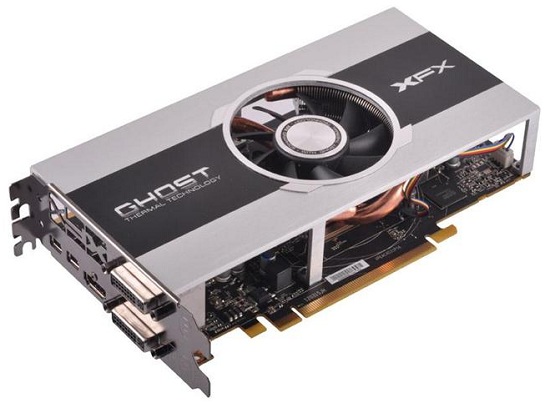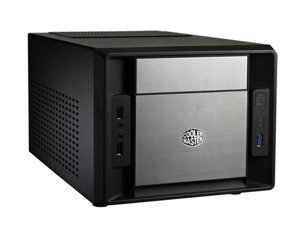Holiday 2012 Small Form Factor Buyer's Guide
by Zach Throckmorton on December 5, 2012 1:55 AM ESTIntel SFF gaming system
The de facto king of the gaming CPUs remains the Intel Core i5-3570K, a quad-core SKU with a base frequency of 3.4GHz that can turbo to 3.8GHz, and features an unlocked multiplier for easy overclocking. Though the K-series chip is easy to overclock and doesn't produce much additional heat (vs. stock) when modestly overclocked, you'll want to exercise caution overclocking in a mini-ITX box.
 To facilitate conservative overclocks of the i5-3570K, ASRock's Z77E-ITX motherboard gets our recommendation for a relatively inexpensive Z77 ITX board that nevertheless performs well. It's also laid out in a manner that facilitates easier cable management than many other Z77 boards when placed in our recommended case, the BitFenix Prodigy. The Prodigy is an interesting case, from its appearance to its internal layout. AnandTech reviewed this unique case recently, and it earned our Editor's Choice. Bluntly, ITX systems are not always a joy to assemble because of the cramped spaces entailed, but I've enjoyed every Prodigy system I've put together.
To facilitate conservative overclocks of the i5-3570K, ASRock's Z77E-ITX motherboard gets our recommendation for a relatively inexpensive Z77 ITX board that nevertheless performs well. It's also laid out in a manner that facilitates easier cable management than many other Z77 boards when placed in our recommended case, the BitFenix Prodigy. The Prodigy is an interesting case, from its appearance to its internal layout. AnandTech reviewed this unique case recently, and it earned our Editor's Choice. Bluntly, ITX systems are not always a joy to assemble because of the cramped spaces entailed, but I've enjoyed every Prodigy system I've put together.
The AMD Radeon HD 7850 1GB yields arguably the best performance for a GPU under $200. Priced roughly the same as the NVIDIA GTX 650 Ti (both can be found around $150 on sale and/or after rebate), the 7850 outperforms the 650 Ti in nearly every metric. You can read more about what to expect from a Radeon HD 7850 1GB card in Ryan's review. Note that in order to accommodate this GPU, you will need to remove the modular drive cage from the Prodigy.
Rounding out the build, we're recommending an 8GB kit of DDR3-1600Mhz (the extremely overclockable Samsung 8GB kit with modest official specs), a standard 1TB hard drive, and like the small form factor file server, a small, modular power supply—the Silverstone ST50F-P.
| Component | Product | Price | Rebate |
| Case | BitFenix Prodigy | $70 | |
| Power supply | Silverstone ST50F-P | $77 | |
| CPU | Intel Core i5-3570K | $215 | |
| Motherboard | ASRock Z77E-ITX | $150 | |
| RAM | Samsung 8GB DDR3-1600MHz | $35 | |
| Graphics card | XFX Core Edition Radeon HD 7850 1GB | $175 | -$20 |
| Hard drive | Seagate ST1000DM003 1TB 7200 RPM | $70 | |
| Optical drive | Samsung SH-224BB | $16 | |
| Operating system | Windows 7 64-bit Home Premium OEM | $92 | |
| Total: | $900 | $880 |
Though this small form factor gaming rig will produce spectacular frame rates in most games, it does so at a price. If you primarily play less demanding games, or play at resolutions lower than 1080p, you can save a lot of money by going with the AMD APU small form factor gaming build we'll detail next.
AMD SFF gaming system
I recently posted an AMD Trinity APU buyer's guide, in which I highlighted the A10-5800K's gaming abilities. Briefly, Crysis: Warhead, Metro 2033, DiRT 3, Total War: Shogun 2, Portal 2, Battlefield 3, Starcraft 2, Elder Scrolls V: Skyrim, Civilization V, World of Warcraft, Left 4 Dead, Diablo 3, Aliens vs. Predator, and Minecraft are all very playable (at least 50-60fps) at 720p resolution and moderate details. Gaming at higher resolutions like 1680x1050 changes consideration of the A10-5800K as a "good enough" gaming processor. Metro 2033 and Aliens vs. Predator in particular start to struggle, and maintaining average frame rates higher than 40fps requires lowering quality settings in most of the remaining titles listed above. You can read more about the top of the line AMD APU's gaming performance in Anand's review.
Unfortunately there are very few Socket FM2 motherboards available in American retail channels that use the ITX form factor. Of the two I've tried, I prefer the MSI FM2-A75IA-E53 because its SATA ports, USB 3.0 front panel header, and 24 pin power connector are all adjacent to each other, which makes stringing cables throughout a small ITX case that much easier.
 Housing the A10 APU and its MSI FM2 motherboard is the Cooler Master Elite 120. Dustin reviewed this case and I agree with his main conclusions: its thermals are somewhat limited and it's better suited to more modest systems. As we've outlined below, there's no discrete GPU in this build, so that concern is simply irrelevant. If you decide to run Hybrid Crossfire aka Dual Graphics at some point in the future, the GPUs recommended for pairing with the A10-5800K are physically small and have relatively low TDPs, so the Elite 120's limited thermals should remain a non-issue. Best of all, this is a lot of case for not much money given its $50 MSRP.
Housing the A10 APU and its MSI FM2 motherboard is the Cooler Master Elite 120. Dustin reviewed this case and I agree with his main conclusions: its thermals are somewhat limited and it's better suited to more modest systems. As we've outlined below, there's no discrete GPU in this build, so that concern is simply irrelevant. If you decide to run Hybrid Crossfire aka Dual Graphics at some point in the future, the GPUs recommended for pairing with the A10-5800K are physically small and have relatively low TDPs, so the Elite 120's limited thermals should remain a non-issue. Best of all, this is a lot of case for not much money given its $50 MSRP.
AMD APUs benefit from faster DDR3, so we're recommending a kit of DDR3-1866MHz here. Take care to not buy a kit that has unnecessarily heatspreaders, as space is at a premium in this ITX build. As stated earlier, hard drive prices are highly variable right now, so keep your eyes on prices. We're recommending a standard 1TB 7200 RPM drive here, which should accommodate even larger gaming libraries. Finally, powering everything we have a standard budget PSU, Antec's Neo Eco 400C. If the Neo Eco 400C isn't priced well in your area of the world, you can always consider the Corsair Builder Series 430W, Antec Earthwatts 380W, or even the Seasonic 300W.
| Component | Product | Price |
| Case | Cooler Master Elite 120 | $40 |
| Power supply | Antec Neo Eco 400C | $40 |
| CPU | AMD A10-5800K APU | $130 |
| Motherboard | MSI FM2-A75IA-E53 | $90 |
| RAM | GEIL Evo Leggara 8GB DDR3-1866MHz | $43 |
| Hard drive | Seagate ST1000DM003 1TB 7200 RPM | $70 |
| Optical drive | Samsung SH-224BB | $16 |
| Operating system | Windows 7 64-bit Home Premium OEM | $92 |
| Total: | $521 |
We have a few concluding remarks on the final page.










74 Comments
View All Comments
Taft12 - Wednesday, December 5, 2012 - link
A 40mm fan? No, no, no, no and no.DanNeely - Wednesday, December 5, 2012 - link
It's a 17W mobile part. A slow 40mm fan is more than sufficient when combined with the improved airflow of even a SFF case when compared to a laptop chassis. The similar sized fan on my 18W E-350 file server has never gotten gotten loud enough to be heard.dananski - Wednesday, December 5, 2012 - link
He's probably concerned about the pitch of the sound. I've avoided anything smaller than a 120mm fan in all my builds as even quiet high pitched noise is a nuissance. Your file server probably has a low CPU load compared to the video playback cyrusfox intends to do, so I'd expect it to stay nice and cool with the fan barely on. He might not be so lucky.As for the board & integrated CPU, seems pretty good value for money, though I'd like to see some more powerful mobile chips in this sort of design. Will probably become more common with Haswell.
cyrusfox - Thursday, December 6, 2012 - link
Board came today, I am load testing it currently. Bios is nice, fan is fully customizable(so much so that you can set it low enough to not turn on) and cpu and gpu power can be altered(step down, you can also underclock the cpu or diable a core-won't be doing that). Trying to see how low it can go and be stable. So far it is silent and not even in its case yet(cardboard build, waiting for the last parts to arrive).You don't need much air flow for a tiny 17watt chip. The fan is removable, so you could just add some heat pipes and make a passive build out of it, CPU good to 100°C. It really is a low profile board, highest part is the audio connector on IO. Whenever Temash gets out, I'll probably replace it, but this should be more than good enough to emulate, stream, and surf on the couch.
ricardoduarte - Wednesday, December 5, 2012 - link
Why are you suggesting 1TB hd, and no SSD in the gaming systems.I would one of these would be better:
-2TB hd, and 256gb ssd would be a better choice.
or
- 3TB hd and 64gb ssd for cache
Norseman4 - Wednesday, December 5, 2012 - link
True it's double the price of the OS, but it looks like Win8's Storage Spaces revives and possibly improves the best part of the original WHS ... Drive Extender.It's be nice to see an investigation into SS and it's direct comparison to DE, though. (I've only seen pages on how to set up a SS, so how it functions is still unknown to me)
DanNeely - Wednesday, December 5, 2012 - link
I looked at W8 + Storage Spaces recently; but benches put it significantly slower than rival fakeraid options. Hopefully MS will be able to patch it up to more competitive levels in an upcoming service pack (Blue?) or W9.bigfire - Wednesday, December 5, 2012 - link
I've had my AMD Athlon 64 X2 for about 6 years and it still works well. I've never had any troubles with this guy.DanNeely - Wednesday, December 5, 2012 - link
What mobo chipset did you use? Both of mine have been dead for over a year after nForce4 boards 4 and 5 followed my first 3 into the grave.amdwilliam1985 - Wednesday, December 5, 2012 - link
Same here, I have x2 2.5ghz with stock fan, it's probably been 5 years now.It's still running as a champ for my workload. The only upgrade I'm made in the past 2 years is the $99 5770 :) great investments.